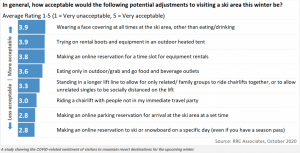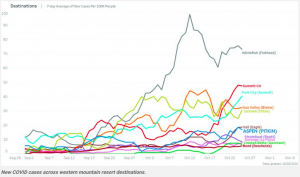More than 20,000 skiers and snowboarders responded, providing insights about the road ahead
By Dave Belin, Director of Consulting at RRC Associates
Brought to you by The Aspen Times, The Insights Collective and the Aspen Chamber Resort Association

The intention to ski and snowboard this winter is strong, season pass purchase is up nationally, and skiers are planning for a socially-distanced, face-covered winter at mountain resorts, with some adjustments to their typical behavior.
These topics and more were part of a comprehensive national survey that RRC Associates conducted with skiers and snowboarders in September of 2020. The survey received over 20,000 responses from all corners of the U.S. and provides unique insight to what skiers and snowboarders are expecting for the 2020/21 season.
The results of the survey give local leaders and resort staff critical information about what visitors, locals, and second homeowners are thinking about in terms of safety, adjustments, concerns and behaviors for this winter.
“Understanding what our visitors are thinking before they get to our resorts is critical,” said Kelly Pawlak, President and CEO of National Ski Areas Association. “This information is another helpful tool we will use to open the winter season with the safety of our staff and guests front and center.”
Visitor concerns
The survey showed that one of the biggest concerns of both visitors and locals alike is whether ski resorts will be able to stay open all winter. People are worried about a situation like the one in March, when resorts were forced to close abruptly. About two-thirds of visitors and locals indicated that they were concerned about Coronavirus-related closures of ski areas. Resorts have been making preparations to address that issue, but maintaining focus on staying open all winter will be critical.
“At our resort we are meeting daily and sometimes multiple times a day internally to stay aware of trends and changes in the way this pandemic is behaving regionally,” said Nick Polumbus, Director of Marketing and Sales at Whitefish Mountain Resort. “We know that it will take constant attention to trends as well as our own protocols and procedures to keep the virus in check and the lifts spinning.”
Other concerns among local residents are whether guests follow health and safety protocols, the overall health and safety of the community, and visitors from major cities/hot spots. Additionally, locals are focused on the potential impact of COVID-19 on the local economy. These legitimate concerns among local residents are important for local leaders to monitor and communicate with community members.
Adjusting behaviors
In terms of skier behavior at the mountain this winter, survey results show that most snowsports enthusiasts are already planning to wear a face covering around the base area and while riding lifts, to make an online appointment to rent equipment, and to eat lunch at their car or outside. The survey also revealed they are generally OK with longer lift lines due to unrelated parties not riding together on chairlifts. Knowing what the guests know ahead of time gives ski areas a head start on guest education and safety.
“Skiers and riders continue to show that they’ll do what it takes to get out on the hill. I am encouraged by the willingness of skiers/riders to wear masks and socially distance. This level of flexibility and resilience among snowsports enthusiasts is impressive, even during a pandemic,” said Jesse True from the Insights Collective.
Skiing midweek will be more common, with nearly half of survey respondents saying they are more likely to ski midweek this winter. Increases in midweek skiing will contribute to spreading skier visits out across the week and could alleviate some weekend crowding, a significant concern for resort operators. On the other hand, carpooling will be somewhat less popular and could therefore strain resort parking infrastructure.
Most downhill skiers do not plan on changing their behavior when it comes to enrolling children in midweek ski lessons (rather than weekends), participation in half-day ski lessons (rather than full-day lessons), or partaking in off-mountain activities like snowshoeing, backcountry skiing, and snowmobiling, Nevertheless, about 1/4 of survey respondents are more likely to take part in off-mountain activities, and resort areas can help to show visitors how to access and safely participate in those alternate activities.
“Resorts and resort towns will need to have plans in place to accommodate this additional demand for alternate activities and to manage capacity appropriately,” said Barb Carpenter, of the Insights Collective. “Communication with visitors about the availability and safety of alternate activities will be key to ensuring a good guest experience.”
Since comfort with dispersed outdoor recreation like ice skating and Nordic skiing is incredibly high, demand for these activities – beyond that from the downhill skiers and snowboarders represented in the survey – is anticipated to be elevated this winter.
Preparing for a different ski season ahead

Communication with visitors will have to be accurate, nimble and frequent. Fortunately, skiers are very receptive to opting-in to receive text message updates from resorts. Email and resort or town apps are also good ways to communicate information to visitors. Towns and ski areas should be planning to use these methods to communicate with visitors this winter.
“This continual use of technology to manage the visitor experience in an effort to provide a seamless experience will become a standard going forward for destinations,” said Carl Ribaudo, President of SMG Consulting and a member of the Insights Collective.
The majority of second homeowners are not anticipating changing the way they normally use their second homes this winter. However, about one in five ski area second homeowners said they would plan to use their home more for themselves or for friends/family, rather than renting it out, which could have implications for the short-term rental inventory in some resort towns. Indeed, skiers responded in the survey that they are more comfortable with rent-by-owner lodging than with a traditional hotel, for a variety of reasons, including safety, cleanliness and the ability to make and eat meals more easily.
These national-level survey results might play out somewhat differently in specific resort towns across the U.S.; however, the results indicate that ski area and town leaders should anticipate a positive, though different, ski season than the past, and that safety, cleanliness, communication, and flexibility will be critical to that success.
